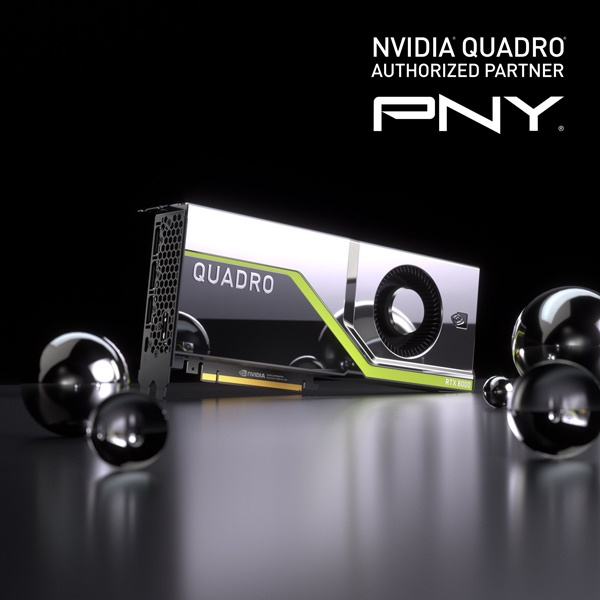
PNY Technologies, an authorized channel partner for NVIDIA Quadro GPUs (graphics processing units), has enabled its partner network to take pre-orders for two new NVIDIA Quadro RTX products. Designed for desktop engineering workstations, the Quadro RTX offers dedicated processors for ray-tracing and artificial intelligence computation. NVIDIA Quadro RTX 6000 image courtesy of NVIDIA and PNY Technologies Inc.
Latest News
October 24, 2018
Dear DE Reader:
At SIGGRAPH last August, NVIDIA announced its new Turing architecture and previewed the first Turing-based products for design and manufacturing workflows: the Quadro RTX series GPUs (graphics processing units). The Turing platform features dedicated processors tuned for ray-tracing and artificial intelligence (AI) tasks.
At the time, NVIDIA said shipments of RTX GPUs would begin in the fourth quarter of 2018. That's now. And PNY Technologies, an authorized channel partner for NVIDIA Quadro GPUs, has just told its reseller, distribution and other partners that they can take pre-orders for the Quadro RTX 6000 and RTX 5000. That means engineering workstations equipped with these GPUs will be available soon.
What's in it for you? Basically, the RTX family seems as honed as present technology gets for manufacturing and scientific visualization, virtual environments, photorealistic real-time rendering, AI-enabled development and anything else you hurl at your workstation.
Hands-on, this means things like instant and interactive photorealistic renderings. You're likely to experience more physically accurate and predictable visualizations of product behaviors. The Quadro RTX family should mean accelerated AI workflow performance the way you've always suspected they could be. Virtual reality as a design tool should become more detailed, more responsive and more realistic (and more fun).
Currently available for pre-order from PNY Technologies' partners are the Quadro RTX 5000 and the RTX 6000. The third Quadro RTX product, the top-of-the-line RTX 8000, comes out in early 2019.
All NVIDIA Quadro RTXs have RT and Tensor Cores. RT Cores are purpose-built ray-tracing processors. They handle computations at rates up to 10 giga rays per second. NVIDIA says that's 25x faster than its Pascal architecture could deliver.
Tensor Cores handle math-heavy computations at up to 500 trillion operations per second. Consequently, AI stuff like deep learning training, inferencing, denoising and other AI-enhanced features should blaze.
Let's pause. You think 5000 = low-end; 6000 mid-range? That doesn't fit. You decide:
The 16GB Quadro RTX5000 provides 8 giga rays per second computations. It has 3,072 CUDA parallel-processing cores, 384 Tensor Cores and 72 RT Cores. The 24GB RTX6000 specs include 10 giga rays per second computations, 576 Tensor Cores, 72 RT Cores and 4,608 NVIDIA CUDA cores. Holy moly.
To really sort that out, tomorrow, PNY Technologies hosts a webinar exploring what NVIDIA's Turing architecture and Quadro RTX GPUs mean for professional design, graphics and visualization workflows. You'll find more details on that and NVIDIA's Quadro RTX GPU series from today's Editor's Pick of the Week write-up.
Thanks, Pal. – Lockwood
Anthony J. Lockwood
Editor at Large, DE
More PNY Technologies Coverage

Subscribe to our FREE magazine, FREE email newsletters or both!
Latest News
About the Author
Anthony J. Lockwood is Digital Engineering’s founding editor. He is now retired. Contact him via de-editors@digitaleng.news.
Follow DE







